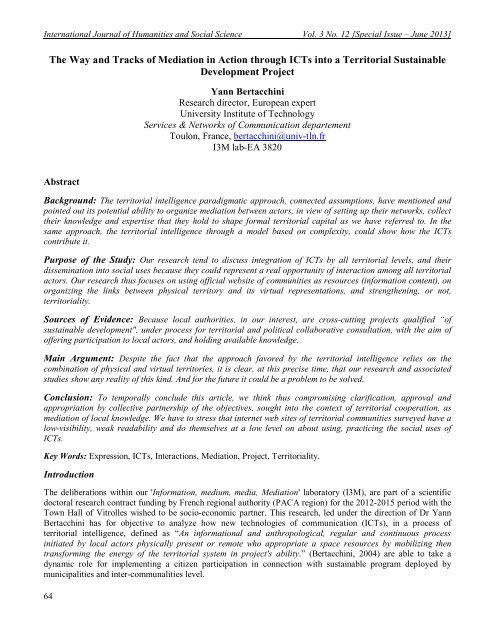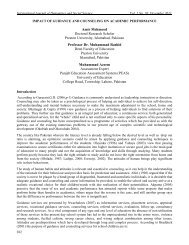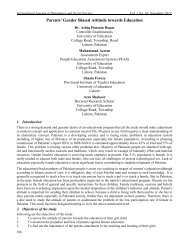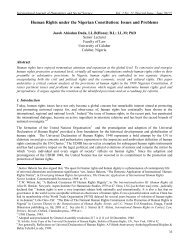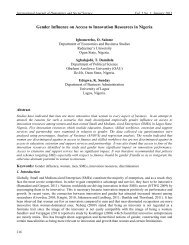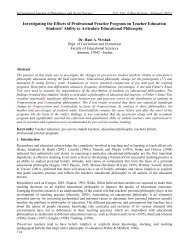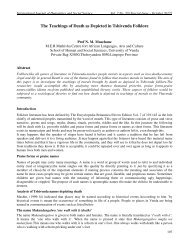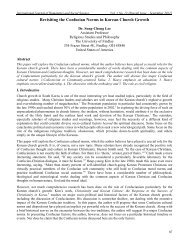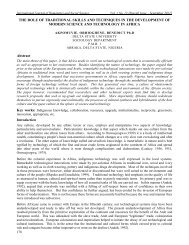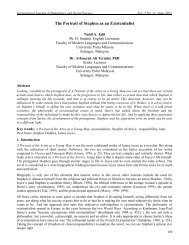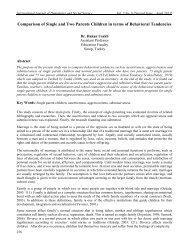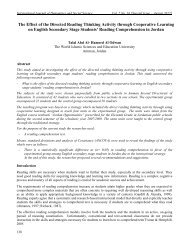Full Text - International Journal of Humanities and Social Science
Full Text - International Journal of Humanities and Social Science
Full Text - International Journal of Humanities and Social Science
Create successful ePaper yourself
Turn your PDF publications into a flip-book with our unique Google optimized e-Paper software.
<strong>International</strong> <strong>Journal</strong> <strong>of</strong> <strong>Humanities</strong> <strong>and</strong> <strong>Social</strong> <strong>Science</strong> Vol. 3 No. 12 [Special Issue – June 2013]<br />
The Way <strong>and</strong> Tracks <strong>of</strong> Mediation in Action through ICTs into a Territorial Sustainable<br />
Development Project<br />
Yann Bertacchini<br />
Research director, European expert<br />
University Institute <strong>of</strong> Technology<br />
Services & Networks <strong>of</strong> Communication departement<br />
Toulon, France, bertacchini@univ-tln.fr<br />
I3M lab-EA 3820<br />
Abstract<br />
Background: The territorial intelligence paradigmatic approach, connected assumptions, have mentioned <strong>and</strong><br />
pointed out its potential ability to organize mediation between actors, in view <strong>of</strong> setting up their networks, collect<br />
their knowledge <strong>and</strong> expertise that they hold to shape formal territorial capital as we have referred to. In the<br />
same approach, the territorial intelligence through a model based on complexity, could show how the ICTs<br />
contribute it.<br />
Purpose <strong>of</strong> the Study: Our research tend to discuss integration <strong>of</strong> ICTs by all territorial levels, <strong>and</strong> their<br />
dissemination into social uses because they could represent a real opportunity <strong>of</strong> interaction among all territorial<br />
actors. Our research thus focuses on using <strong>of</strong>ficial website <strong>of</strong> communities as resources (information content), on<br />
organizing the links between physical territory <strong>and</strong> its virtual representations, <strong>and</strong> strengthening, or not,<br />
territoriality.<br />
Sources <strong>of</strong> Evidence: Because local authorities, in our interest, are cross-cutting projects qualified “<strong>of</strong><br />
sustainable development", under process for territorial <strong>and</strong> political collaborative consultation, with the aim <strong>of</strong><br />
<strong>of</strong>fering participation to local actors, <strong>and</strong> holding available knowledge.<br />
Main Argument: Despite the fact that the approach favored by the territorial intelligence relies on the<br />
combination <strong>of</strong> physical <strong>and</strong> virtual territories, it is clear, at this precise time, that our research <strong>and</strong> associated<br />
studies show any reality <strong>of</strong> this kind. And for the future it could be a problem to be solved.<br />
Conclusion: To temporally conclude this article, we think thus compromising clarification, approval <strong>and</strong><br />
appropriation by collective partnership <strong>of</strong> the objectives, sought into the context <strong>of</strong> territorial cooperation, as<br />
mediation <strong>of</strong> local knowledge. We have to stress that internet web sites <strong>of</strong> territorial communities surveyed have a<br />
low-visibility, weak readability <strong>and</strong> do themselves at a low level on about using, practicing the social uses <strong>of</strong><br />
ICTs.<br />
Key Words: Expression, ICTs, Interactions, Mediation, Project, Territoriality.<br />
Introduction<br />
The deliberations within our 'Information, medium, media, Mediation' laboratory (I3M), are part <strong>of</strong> a scientific<br />
doctoral research contract funding by French regional authority (PACA region) for the 2012-2015 period with the<br />
Town Hall <strong>of</strong> Vitrolles wished to be socio-economic partner. This research, led under the direction <strong>of</strong> Dr Yann<br />
Bertacchini has for objective to analyze how new technologies <strong>of</strong> communication (ICTs), in a process <strong>of</strong><br />
territorial intelligence, defined as “An informational <strong>and</strong> anthropological, regular <strong>and</strong> continuous process<br />
initiated by local actors physically present or remote who appropriate a space resources by mobilizing then<br />
transforming the energy <strong>of</strong> the territorial system in project's ability.” (Bertacchini, 2004) are able to take a<br />
dynamic role for implementing a citizen participation in connection with sustainable program deployed by<br />
municipalities <strong>and</strong> inter-communalities level.<br />
64
The Special Issue on <strong>Humanities</strong> <strong>and</strong> Behavioral <strong>Science</strong> © Center for Promoting Ideas, USA www.ijhssnet.com<br />
We support our research on several projects including the peculiarity lies in the inclusion <strong>of</strong> territorial actors on<br />
defining <strong>and</strong> establishing the orientations chosen for a concerted territorial development. We are considering three<br />
kind <strong>of</strong> sustainable development project designed by the following expression <strong>and</strong> acronym: local Agenda 21<br />
(A21L), climate, energy territorial plan (PCET) <strong>and</strong> the regional global program for innovating action (A.G.I.R)<br />
analyzed through all the territorial communities <strong>of</strong> the PACA region involved, in at least, one <strong>of</strong> the 3 projects.<br />
For this, as the first step <strong>of</strong> this study, we have identified all <strong>of</strong> the <strong>of</strong>ficial websites <strong>of</strong> each territorial community<br />
declared to be engaged in, at minima, one sustainable development program. Following this enumeration act, we<br />
have conducted their qualitatively <strong>and</strong> quantitatively analyze for the relevance <strong>of</strong> their uses (criteria as for<br />
example, ergonomics, features, interactive dimension, etc.), quality <strong>of</strong> the information put around <strong>of</strong> project<br />
implementation at local level <strong>and</strong> apprehension <strong>of</strong> the receivers in their underst<strong>and</strong>ing <strong>of</strong> issues <strong>and</strong> dynamic <strong>of</strong><br />
the territory concerned. In the first part <strong>of</strong> this article, we will return to the theoretical basis <strong>of</strong> our research within<br />
the paradigm <strong>of</strong> the territorial intelligence. Then, we will describe the methodology used in this particular step <strong>of</strong><br />
research studies <strong>and</strong> the different criteria used in the construction <strong>of</strong> the empirical analysis. Finally, we will<br />
present the initial results <strong>and</strong> for intermediary conclusion, we extract the main aspects.<br />
1. Paradigmatic Framework <strong>and</strong> Methodology Description<br />
Before presenting the research methodology used for this specific phase <strong>of</strong> studies, we here shall specify the<br />
epistemological framework for our research <strong>and</strong> outline, the content <strong>and</strong> the associated assumptions within the<br />
paradigm <strong>of</strong> the territorial intelligence.<br />
1.1. Paradigmatic <strong>and</strong> Epistemological Framework: The Territorial Intelligence <strong>and</strong> the Associated<br />
Assumptions<br />
There are many definitions <strong>and</strong> contexts in which the concept <strong>of</strong> social innovation makes sense, both into the field<br />
<strong>of</strong> public action than that <strong>of</strong> entrepreneurship or by the actors <strong>of</strong> social <strong>and</strong> solidarity economy. <strong>Social</strong> innovation<br />
can be defined as “a local initiative that connects the response to social needs, the ability <strong>of</strong> participation <strong>of</strong><br />
stakeholders, in particular excluded groups, governance <strong>and</strong> access to the resources necessary for the<br />
satisfaction <strong>of</strong> these needs.” (Hillier et al, 2004 in Richez-Battesti & al, 2012). It relies on groups <strong>of</strong> actors,<br />
existing before either building into the innovation process. It flows as a priority <strong>of</strong> new arrangements, relationship<br />
modes, <strong>and</strong> modes <strong>of</strong> participation, modes <strong>of</strong> life, new organizations, collaborations <strong>and</strong> cooperation between<br />
actors, organizations or communities <strong>of</strong> the society (Pybourdin, 2010)<br />
Therefore, sustainable development <strong>and</strong> territorial intelligence are strongly linked around the concept <strong>of</strong> social<br />
innovation, characteristics which are shared. Indeed, sustainable development <strong>and</strong> territorial intelligence are based<br />
on the same issues: searching for a combination <strong>of</strong> the close, the local, <strong>and</strong> the distant, global; territorial<br />
cooperation with the networking <strong>of</strong> actors <strong>and</strong> the confrontation <strong>of</strong> their expertise (i.e., expert <strong>and</strong> lay citizen)<br />
(Maurel, 2012), (Bertacchini & Al, 2012 <strong>and</strong> 2013); All this in view <strong>of</strong> establishing an information coupled with a<br />
territorial communication process.<br />
Finally, at a time where cultural changes related to the development <strong>of</strong> technologies <strong>of</strong> information <strong>and</strong><br />
communication (ICTs) <strong>and</strong> new forms <strong>of</strong> indirect confrontations resulting from this technological evolution are<br />
still poorly identified by the actors <strong>of</strong> the territory (Bertacchini, 2009). Territorial intelligence arises as a real<br />
innovation for the local territory (Herbaux, 2007). Our interest in this emerging concept (from 15 years) comes<br />
from its most basic analysis on the development <strong>of</strong> the Information Society <strong>and</strong> sustainable development<br />
(Girardot, 2004). In addition, territorial intelligence can be considered at double side, a program <strong>and</strong> tools, to the<br />
help <strong>of</strong> sustainable territorial development players. Possibility is also <strong>of</strong>fering to develop territory in its culture<br />
encouraging an approach whose objective is to provide to the territorial level to be developed with the 'territorial<br />
formal capital' (Bertacchini, 2004, 2009).<br />
Prerequisite for any endogenous development policy, Bertacchini defined the territorial formal capital as "a set <strong>of</strong><br />
values, codes, rules, modalities <strong>of</strong> interaction <strong>and</strong> coordination <strong>of</strong> explicit knowledge in digital documents,<br />
recognized <strong>and</strong> shared by the actors <strong>of</strong> the territory to formulate <strong>and</strong> implement a joint local development<br />
project." (Bertacchini, 2004).<br />
65
<strong>International</strong> <strong>Journal</strong> <strong>of</strong> <strong>Humanities</strong> <strong>and</strong> <strong>Social</strong> <strong>Science</strong> Vol. 3 No. 12 [Special Issue – June 2013]<br />
Territorial intelligence arises therefore as a real help on setting up territorial formal capital which implications<br />
would be for the commitment <strong>and</strong> the recognition <strong>of</strong> local skills in the actions undertaken, acceptance <strong>of</strong> common<br />
rules <strong>and</strong> procedures by local actors, exchange <strong>of</strong> expertise recognized actors, premises as well as their<br />
recognition <strong>and</strong> mobilization around the territorial project (Bertacchini, ibidem).<br />
As a stakeholder-oriented approach, the territorial intelligence is designed to allow partnerships <strong>of</strong> stakeholders to<br />
better underst<strong>and</strong> their territory;<br />
Implement capacity the citizen, implying to include it in a process <strong>of</strong> learning by recognition in the projects <strong>and</strong><br />
local practices through a process <strong>of</strong> action, awareness, training, initiation, accompanying entitled “methodological<br />
path" (Herbaux, 2007). Set capacity, the territorial actors are considered beyond simple performers since they<br />
have now a power <strong>of</strong> proposal <strong>and</strong> access management actions implemented. Their expertise to use can be<br />
collected but it really depends on how the local authorities are engaged <strong>and</strong> managing this collect;<br />
More generally, the objective is to involve local actors <strong>and</strong>, beyond, the territorial community (Girardot, 2004), by<br />
sharing their information in order to create information systems that allow them improving their collective<br />
knowledge <strong>of</strong> territorial dynamics, projects developed by the territory. The success <strong>of</strong> this objective depends on<br />
several conditions: it must not be only that local stakeholders take ownership <strong>of</strong> ICTs but also to implement in an<br />
organized way these technologies because the organizational process will depend on the quality <strong>of</strong> information<br />
collected <strong>and</strong> produced as well as the cooperation within partnerships <strong>of</strong> actors.<br />
1.2. Empirical Analysis <strong>and</strong> the Research Conditions<br />
Our geographic field <strong>of</strong> research is limited in France to the PACA region (South East France) <strong>and</strong> its sub<br />
territories (departments in French): Alpes de haute Provence, Alpes maritimes, Bouches-du-Rhône, Hautes Alpes,<br />
Var et Vaucluse. For each <strong>of</strong> this sub territory we have identified all the local authorities (municipalities <strong>and</strong> intercommunalities)<br />
engaged in, at least, one <strong>of</strong> the three projects <strong>of</strong> sustainable development mentioned above.<br />
The AL21 (local agenda) is a territorial sustainable development approach advocated in 1992 to the Earth Summit<br />
in Rio de Janeiro, the climate-energy territorial Plan is <strong>of</strong>ten to come focusing as device specifically dealing with<br />
the fight against climate change <strong>and</strong> protection <strong>of</strong> the atmosphere.<br />
Indeed, the national reference framework <strong>of</strong> territorial projects for sustainable development <strong>and</strong> local Agenda 21,<br />
engaged in France by the “Ministry <strong>of</strong> Ecology, sustainable development <strong>and</strong> energy” (formerly the Ministry <strong>of</strong><br />
ecology, energy, sustainable development <strong>and</strong> spatial planning), holds five priorities:<br />
-The fight against climate change <strong>and</strong> the protection <strong>of</strong> the atmosphere;<br />
-Conservation <strong>of</strong> biodiversity, protection <strong>of</strong> the environments <strong>and</strong> resources;<br />
-Development <strong>of</strong> all human beings;<br />
-<strong>Social</strong> cohesion <strong>and</strong> solidarity between territories <strong>and</strong> between generations;<br />
-Dynamics <strong>of</strong> development following responsible production <strong>and</strong> consumption patterns.<br />
Concerning the AGIR program, it is a regional arrangement launched in 2006 <strong>and</strong> whose purpose is to financially<br />
support exemplary <strong>and</strong> innovative projects aiming to promote energy savings <strong>and</strong> renewable energy in order to<br />
strengthen the fight against climate change <strong>and</strong> ensure the economic development <strong>of</strong> the territory. Just as the<br />
articulation between CFEP <strong>and</strong> LA21, this program, dedicated to the municipal level, can also act in addition with<br />
other projects. Interest to focus our research on these 3 devices is that they are all resulting from a voluntary<br />
approach (except m<strong>and</strong>atory CFEP for the territorial communities <strong>of</strong> 50,000 inhabitants <strong>and</strong> more) in consistency<br />
from a global policy <strong>of</strong> sustainable development, in particular through participatory processes involved <strong>and</strong><br />
actively mobilize all local actors (citizens, residents, community associations, etc.).<br />
Furthermore, following the inventory <strong>of</strong> the territorial communities located into the region engaged in one or<br />
more projects, we have implemented a watch monitoring process on Internet. This search stage was designed to<br />
obtain the percentage <strong>of</strong> communities with an <strong>of</strong>ficial or not website. Subsequently, in accordance with the<br />
typology <strong>of</strong> the web tools developed by Nicolas Vanbremeersch (2009) in his book entitled "digital democracy",<br />
66
The Special Issue on <strong>Humanities</strong> <strong>and</strong> Behavioral <strong>Science</strong> © Center for Promoting Ideas, USA www.ijhssnet.com<br />
we performed a quantitative analysis <strong>of</strong> uses <strong>of</strong> these tools by communities into the Paca Region through their<br />
website, when one is available. From this, we infer some facts. For the institutional world that makes sense for our<br />
study, the communication approach <strong>and</strong> reporting is the same as that which was practiced <strong>of</strong>fline. There is no<br />
change <strong>of</strong> approach: it merely to make available. The information is top-down <strong>and</strong> the interaction has not yet<br />
existence. The web is only used instead <strong>of</strong> archiving digitized content. We are in media logic where the web is<br />
only used as a means <strong>of</strong> dissemination. There is a real publication but without any publicity. The website has no<br />
web link pointing to him <strong>and</strong> almost no link exists so not in the territory <strong>of</strong> the web. Without binding, blind, his<br />
unpopularity condemn it to oblivion.<br />
Through the reign <strong>of</strong> internet documentary the expert skill is delivering his knowledge, regardless <strong>of</strong> its grip by<br />
others. The contents <strong>of</strong> the documentary web derive from the traditional public space finding a new advertising.<br />
However, once published on the web, content does not circulate <strong>and</strong> therefore lacks the potential <strong>of</strong>fered by the<br />
Internet in terms <strong>of</strong> exchanges <strong>and</strong> interaction. What gives life to these contents are other areas <strong>of</strong> the web: the<br />
Web <strong>of</strong> Information, the <strong>Social</strong> web, <strong>and</strong> the Semantic web we now shall define. So this typology is available in<br />
three categories <strong>and</strong> documentary web has been dropped in favor <strong>of</strong> the web qualified <strong>of</strong> "semantics":<br />
- The Information Web<br />
It is not always in an interactive approach, but there is a concern <strong>of</strong> grip <strong>of</strong> the information by the receiver.<br />
Therefore, the web site becomes further via online text <strong>and</strong> data available with also video, maps <strong>and</strong> graphics.<br />
However, specificity <strong>of</strong> this web is the immediacy <strong>of</strong> information <strong>and</strong> news, that user can be informed in real time<br />
<strong>of</strong> new content online, new information. In this category, we stop our search to RSS <strong>and</strong> Newsletter.<br />
- The <strong>Social</strong> Web<br />
The expression web 2.0 may appear false <strong>and</strong> inadequate because early on the Internet contained the social logic<br />
<strong>of</strong> sharing information, discussion or comments directly between individuals. The evolution perhaps comes<br />
through emergence <strong>of</strong> individualism with network breaking with collective design <strong>of</strong> forums for example<br />
dimension; but also st<strong>and</strong>ardization <strong>of</strong> some web tools <strong>and</strong> the consistency <strong>of</strong> networks format allowing millions<br />
<strong>of</strong> sites <strong>and</strong> dialogue between them. The tools chosen for our research are social networks as Facebook <strong>and</strong><br />
Tweeter.<br />
- The Semantic Web<br />
Without focusing on s<strong>of</strong>tware for underst<strong>and</strong>ing the content, we want to look at the semantics Web as a tool for<br />
greater precision in queries <strong>and</strong> responses, thus facilitating the task <strong>of</strong> the user in its collection <strong>of</strong> information. So<br />
let's look at search engines, folksonomy (keywords, tags, when you associate a representative to our contribution<br />
term so a keyword cloud is formed) but also to pages dedicated to the description <strong>of</strong> projects undertaken by the<br />
community as well as to obtain information on public consultation meetings, participatory processes to collect<br />
opinion <strong>of</strong> population.<br />
2. Communication <strong>of</strong> Primary Research Results <strong>and</strong> Discussion<br />
We now present the key results produced by the end <strong>of</strong> this step <strong>of</strong> empirical analysis began with an inventory <strong>of</strong><br />
ICTs used by local authorities identified as having a website <strong>and</strong> engaged in, a minima, one sustainable<br />
development program.<br />
67
<strong>International</strong> <strong>Journal</strong> <strong>of</strong> <strong>Humanities</strong> <strong>and</strong> <strong>Social</strong> <strong>Science</strong> Vol. 3 No. 12 [Special Issue – June 2013]<br />
Table 1. Census <strong>of</strong> number <strong>of</strong> projects initiated by municipalities according to the type <strong>of</strong> territorial<br />
communities <strong>and</strong> department<br />
Inter municipality<br />
Alpes de haute Provence A21L = 2<br />
PCET = 0<br />
Alpes maritimes A21L = 1<br />
PCET = 4<br />
Bouches-du-rhône A21L = 2<br />
PCET = 6<br />
Hautes Alpes A21L = 0<br />
PCET = 0<br />
Var A21L = 1<br />
PCET = 3<br />
Vaucluse A21L = 2<br />
PCET = 2<br />
Municipality<br />
A21L = 0<br />
PCET = 0<br />
AGIR = 11<br />
A21L = 11<br />
PCET = 5<br />
AGIR = 8<br />
A21L = 18<br />
PCET = 4<br />
AGIR = 16<br />
A21L = 3<br />
PCET = 1<br />
AGIR = 14<br />
A21L = 8<br />
PCET = 4<br />
AGIR = 9<br />
A21L = 6<br />
PCET = 2<br />
AGIR = 9<br />
Legend used in the previous tab 1: A21L: 21 local agenda, PCET : territorial energy climate plan, AGIR :<br />
Paca regional label<br />
Here it is a brief comment <strong>of</strong> the collected information. At the regional level, in April 2012, we encountered a<br />
number <strong>of</strong> 67 towns bearing this AGIR label, against 46 A21L (local agenda) <strong>and</strong> 16 CFEP (energy climate).<br />
2.1. Quantitative Surveys on Territories engaged into a Sustainable Development Program <strong>and</strong> First<br />
Qualitative Hypothesis<br />
First <strong>of</strong> all, we note that all territories (departments in French) concerned within our study, share a commitment <strong>of</strong><br />
a number <strong>of</strong> municipalities engaged in, at least, one <strong>of</strong> the three projects chosen for our analysis. Furthermore, <strong>and</strong><br />
for all territories (departments in French), except for the Bouches-du-Rhône, the AGIR labeling Act seems to be<br />
central compared to the other sustainable development projects. Moreover, at the regional level, in April 2012,<br />
we encountered a number <strong>of</strong> 67 towns bearing this AGIR label, against 46 A21L (local agenda) <strong>and</strong> 16 CFEP<br />
(energy climate).<br />
We put forward the hypothesis <strong>of</strong> an approach less restrictive in comparison to the implementation <strong>of</strong> an A21L or<br />
CFEP process that involves the phases <strong>of</strong> shared diagnosis, consultation around the action plan, monitoring <strong>and</strong><br />
evaluation <strong>of</strong> the project with all actors <strong>of</strong> the territory. The comparison between local authorities engaged<br />
through a sustainable development program highlights highest CFEP at the inter-communal level while this report<br />
is at the opposite for the A21L.The assumption we have take in consideration is that the legal obligation for the<br />
territorial communities <strong>of</strong> 50,000 <strong>and</strong> more inhabitants push to implement a CFEP.<br />
However, in general, the inter-municipalities include a larger number <strong>of</strong> inhabitants than the majority <strong>of</strong> the<br />
municipalities. On the A21L <strong>and</strong> CFEP linking, it is to underline that according to the provisions <strong>of</strong> article L229-<br />
26 <strong>of</strong> the Code <strong>of</strong> the Environment (www.legifrance.gouv.fr): “When these public authorities engage themselves<br />
in the development <strong>of</strong> a territorial project <strong>of</strong> local Agenda 21 or sustainable development, territorial climate<br />
energy plan is the climate component.”<br />
68
The Special Issue on <strong>Humanities</strong> <strong>and</strong> Behavioral <strong>Science</strong> © Center for Promoting Ideas, USA www.ijhssnet.com<br />
At this step we see through our analysis that this provision is not always respected. On the other h<strong>and</strong>, may we<br />
stress the coherence <strong>and</strong> relevance <strong>of</strong> creating a climate dimension within a territorial sustainable development<br />
project as the AGIR program, whose main goal is to promote energy savings <strong>and</strong> renewable energy in order to<br />
strengthen the fight against climate change?<br />
Figure 1. Percentage <strong>of</strong> the territorial communities <strong>of</strong> the PACA region with an <strong>of</strong>ficial or non-<strong>of</strong>ficial web<br />
site<br />
2.2. Quantitative Surveys on Territories Using ICT’s <strong>and</strong> first qualitative Hypothesis<br />
Following the census <strong>of</strong> 119 territorial communities <strong>of</strong> the region involved in at least one <strong>of</strong> the sustainable<br />
development program, we also conducted, during three months, a watch on Internet to assess the percentage <strong>of</strong><br />
<strong>of</strong>ficial web site dedicated to municipalities <strong>and</strong> inter municipalities <strong>of</strong> our study. When the site does exist, we<br />
quantitatively analyzed the presence or not <strong>of</strong> different tools selected on the basis <strong>of</strong> the previously described<br />
categories <strong>of</strong> Web.<br />
For the Web <strong>of</strong> Information category our choice fell on services as newsletter, RSS feeds <strong>and</strong> e-mail or online<br />
contact form tab. Concerning, the Semantic Web category we selected Search engine, folksonomies, <strong>and</strong> pages<br />
dedicated to the project (s) as well as the process <strong>of</strong> debate. Finally, for the <strong>Social</strong> Web category we identified<br />
social networks as Facebook <strong>and</strong> Tweeter. Once our analytical grid completed in function <strong>of</strong> each selected tool for<br />
our field study, we performed a statistical <strong>and</strong> graphical analysis. We note that 93.9% <strong>of</strong> municipalities <strong>and</strong> 89.5%<br />
<strong>of</strong> the inter municipalities rely to this socio-technical system to inform <strong>and</strong> communicate on municipal action.<br />
Therefore, we can say that the use <strong>of</strong> this technology is widespread across local authorities.<br />
Figure 2. Percentage <strong>of</strong> the territorial communities <strong>of</strong> the PACA region using the tool(s) Facebook <strong>and</strong><br />
Tweeter through their website<br />
69
<strong>International</strong> <strong>Journal</strong> <strong>of</strong> <strong>Humanities</strong> <strong>and</strong> <strong>Social</strong> <strong>Science</strong> Vol. 3 No. 12 [Special Issue – June 2013]<br />
Figure 3. Percentage <strong>of</strong> the territorial communities <strong>of</strong> the PACA region with a search engine, folksonomy, a<br />
project page <strong>and</strong> dedicated to the organizational arrangements for the consultation<br />
We continued beyond the quantitative analysis on the basis <strong>of</strong> categories defined previously.<br />
We note that the French South territories (departments in French) named Alpes de haute Provence <strong>and</strong> Hautes<br />
Alpes present local authorities with little functional web sites with tools few mobilized (search engine, RSS feeds,<br />
social networks) see nonfunctional or absent: Newsletter, Folksonomy (Figures 3 et 4). Organization <strong>of</strong> the<br />
informational content stated that little explanation dedicated to the project(s) <strong>and</strong> associated consultation process<br />
(Figure 3). Moreover, a certain trends occur also at a regional level since only 4.2% local authorities make use<br />
Folksonomy (Figure 3), 65.6% presents a newsletter subscription that does not work (Figure 4) <strong>and</strong> only 7.6%<br />
(Figure 2) reference using social networks (Facebook <strong>and</strong>/or Tweeter pr<strong>of</strong>ile).<br />
However, we note that the Search engine function is a service usually <strong>of</strong>fered by all the local web sites authorities<br />
(Figure 3) with 70.6% on the whole region <strong>and</strong> that approximately 58% intend to dedicate a page explaining their<br />
project. However, less than 40% <strong>of</strong> the web site show a page dedicated to collect the expression <strong>of</strong> secular actors<br />
<strong>and</strong> make available information through spaces for debate <strong>and</strong> confrontation <strong>of</strong> opinions (Figure 3).<br />
Figure 4. Percentage <strong>of</strong> the territorial communities <strong>of</strong> the PACA region with a RSS feed <strong>and</strong> newsletter in<br />
working condition<br />
70
The Special Issue on <strong>Humanities</strong> <strong>and</strong> Behavioral <strong>Science</strong> © Center for Promoting Ideas, USA www.ijhssnet.com<br />
Conclusion<br />
If we are considering territorial cooperation through territorial intelligence paradigmatic approach <strong>and</strong> framework,<br />
as we shown it in the very beginning <strong>of</strong> our article, “as a share process <strong>of</strong> objectives between all stakeholders in<br />
order to involve them into territorial content creation” (Bertacchini & al, 2012), we have to stress that internet<br />
web sites <strong>of</strong> territorial communities surveyed have a low-visibility, weak readability <strong>and</strong> do themselves at a low<br />
level on about using, practicing the social uses <strong>of</strong> ICTs. As an aid to the establishment <strong>of</strong> a territorial formal<br />
capital, territorial intelligence proposes to reverse or reaffirm the establishment <strong>of</strong> information channels through<br />
networks to be shaped between actors <strong>and</strong> local communities. Beyond the dissemination <strong>of</strong> content, the website<br />
has the primary <strong>and</strong> essential particularity on connecting with the other territories <strong>of</strong> the web (social networks,<br />
forum, chat, blog, <strong>and</strong> other websites <strong>of</strong> interest) to match <strong>and</strong> combine communication tools which, beyond the<br />
transmission <strong>of</strong> the message, symbolize intentionality.<br />
Therefore, the communities position, seen through their <strong>of</strong>ficial website, <strong>and</strong> the different social uses <strong>of</strong> ICTs<br />
permitted does not only communicate content but especially interfere within the interrelations <strong>of</strong> actors in the<br />
socio-technical system to which they belong to (Agostinelli, 2001). For so, we have conducted a watch on the<br />
Internet in order to identify the Web tools used, or not, through the study <strong>of</strong> the <strong>of</strong>ficial website <strong>of</strong> each<br />
community. Indeed, at a time <strong>of</strong> the democratization <strong>of</strong> Internet which is a daily activity for nearly 87% <strong>of</strong><br />
Internet users connecting to the Web almost everyday (Médiamétrie, 2012), builds social networks as 77% <strong>of</strong><br />
Internet users are registered <strong>and</strong>, among them, 2 in all 3 connect daily (Ibid.). Finally, it has to be taken into<br />
consideration the ease <strong>and</strong> speed <strong>of</strong> information as one <strong>of</strong> the main reasons for which individuals connect<br />
themselves to Internet (Granjon, Foulgoc, 2010).<br />
At the French regional level, as our research was displayed, barely more than 20% <strong>of</strong> all websites are positioned<br />
on social networks (Facebook & Tweeter tools) <strong>and</strong> we are still studying their use on a daily basis<br />
quantitative/qualitative analysis. If a little more <strong>of</strong> half the internet web sites (about 58%) propose to dedicate a<br />
page to explain their action in a sustainable project, less than 40% provides a page to collect expression <strong>of</strong> secular<br />
actors <strong>and</strong> make available information on spaces dedicated to debate <strong>and</strong> confrontation <strong>of</strong> such opinions.<br />
Tools to follow news in real time (needs <strong>of</strong> population), such as newsletters <strong>and</strong> Smartphone application, do not<br />
work or are little used. In fact, <strong>and</strong> following our study, there appears to be a gap between ICTs democratization<br />
access <strong>and</strong> the ‘communities’ position on the societal change <strong>of</strong> practices. To temporally conclude this step <strong>of</strong> our<br />
particular study, we think thus compromising clarification, approval <strong>and</strong> appropriation by collective <strong>of</strong> the<br />
objectives sought into the context <strong>of</strong> territorial cooperation, as mediation <strong>of</strong> local knowledge.<br />
The following question “Can we use ICTs, in a pr<strong>of</strong>itable way into the territory between local actors, to engage<br />
then mobilize citizens, local actors, communities, association for action in direction <strong>of</strong> sustainable development<br />
program?” This is our main purpose in the research we are conducting.<br />
References<br />
Agostinelli, S., (2001). « Voies de recherche en science de l’information et de la communication : le rôle des<br />
artefacts et des organisations sociales dans la communication des connaissances. », Note de synthèse pour<br />
l’habilitation à diriger des recherches en sciences de l’information et de la communication, Institut<br />
universitaire de la formation des maîtres de l’Académie d’Aix-Marseille.<br />
Bertacchini, Y., Maurel, P., Deprez, P., Plant, R., (2013). « Spatial information & communication arrangements: a<br />
contribution to territorial intelligence. », <strong>International</strong> <strong>Journal</strong> <strong>of</strong> Emerging Trends in Computing <strong>and</strong><br />
Information <strong>Science</strong>s, ISSN 2079-8407, http://www.cisjournal.org , Vol. 4 No. 1, January.<br />
Bertacchini, Yann., Maurel, Pierre., Deprez, Paul., (2013). “The Territorial Intelligence: A Network Concept <strong>and</strong><br />
An Info-Communication Process Framework”, New Research into Culture, Media, Communication <strong>and</strong><br />
<strong>Social</strong>ization, compilations <strong>of</strong> the first ISCL Izmir, Editor Dr. Ahmet Bese.<br />
Bertacchini, Y., (2012.) “Between information <strong>and</strong> communication process, the territorial intelligence, as a<br />
network concept & a framework to shape local development.”, <strong>International</strong> <strong>Journal</strong> <strong>of</strong> <strong>Humanities</strong> <strong>and</strong><br />
<strong>Social</strong> <strong>Science</strong>, IJHSS, ISSN 2220-8488 (Print), 2221-0989 (Online) http://www.ijhssnet.com, Vol. 2 No.<br />
18 Louisville KY 40202, U.S.A, September.<br />
71
<strong>International</strong> <strong>Journal</strong> <strong>of</strong> <strong>Humanities</strong> <strong>and</strong> <strong>Social</strong> <strong>Science</strong> Vol. 3 No. 12 [Special Issue – June 2013]<br />
Bertacchini, Y. (2004). « Entre information & processus de communication : l’intelligence territoriale. », Revue<br />
Humanisme et Entreprise, Les Cahiers du Centre d’études et de Recherche, La Sorbonne Nouvelle, Paris,<br />
n°267.<br />
Girardot, J-J., (2004). « Intelligence territoriale et participation. », <strong>International</strong> <strong>Journal</strong> <strong>of</strong> Information <strong>Science</strong>s<br />
for Decision Making, n°163.<br />
Granjon, F., Le Foulgoc, A., (2010). « Les usages sociaux de l’actualité » L’Expérience médiatiques des publics<br />
internautes, Réseaux, 2010/2 n°160-161, p. 225-253.<br />
Herbaux, P., (2003). « Mutualisation et intelligence territoriale. », <strong>International</strong> <strong>Journal</strong> <strong>of</strong> Information <strong>Science</strong>s<br />
for Decision Making, n°142.<br />
Herbaux, Ph., Bertacchini, Y., (2007). « Part du construit sémiologique en intelligence territoriale », in: Actes du<br />
6°colloque international ‘Tic et Territoire: quels développements ?’, Université Jean Moulin, Lyon 3,<br />
<strong>International</strong> <strong>Journal</strong> <strong>of</strong> Information <strong>Science</strong>s for Decision Making, juin.<br />
Hillier, J., Moulaert, F., Nussbaumer, J., (2004), « Trois essais sur le rôle de l’innovation sociale dans le<br />
développement territorial », Géographie, Economie et Sociétés, 2 (6), 129-152.<br />
Latour, B., (2005). Reassembling the social: an introduction to actor-network-theory, New York, Oxford<br />
University Press.<br />
Lévy P., (1997). Collective Intelligence: Mankind’s Emerging World in Cyberspace. Plenum, New York.<br />
P. Maurel, (2012). “Signs, data, Spatial Representations: sense meaning items on conceiving a local interauthority<br />
project. Application to the Thau territory. », Université du Sud Toulon/Var, Toulon. p. 583.<br />
Pybourdin, I., (2010). « Repenser la communication des organisations: Liens, réseaux et coopération 2.0. », Les<br />
cahiers du numérique, 2010/1 (Vol.6)<br />
Richez-Battesti Nadine et al., (2012). « L'innovation sociale, une notion aux usages pluriels : Quels enjeux et défis<br />
pour l'analyse ? », Innovations, 2012/2 n°38, p. 15-36.<br />
Robert M. Bond, Christopher J. Fariss, Jason J. Jones, Adam D. I. Kramer, Cameron Marlow, Jaime E. Settle.<br />
(2012). “A 61-million-person experiment in social influence <strong>and</strong> political mobilization.”, Nature, Nature<br />
Publishing Group, september.<br />
Schwarz A. E., (1992). “Generic model describing the complexification <strong>and</strong> autonomization <strong>of</strong> natural systems<br />
<strong>and</strong> its epistemological consequences.” In 6th <strong>International</strong> Conference on Systems Research Informatics<br />
<strong>and</strong> Cybernetics, Baden-Baden.<br />
Vanbremeersch, N., (2009). De la démocratie numérique. Editions du Seuil, collection médiathèque.<br />
Webographie : http://www.mediametrie.fr/<br />
72


